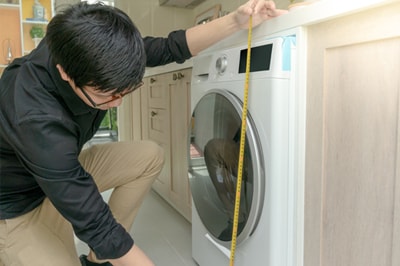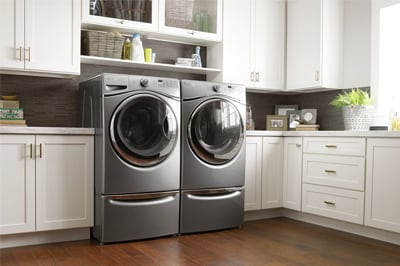How to Measure Washers and Dryers for Installation
Posted on November 15, 2020 By Alison P
Whether you're replacing an existing washer and dryer or you're bringing laundry appliances into your home for the first time, taking proper measurements of the space is extremely important before you make your purchase. You're not just measuring for the appliances themselves - you've got to make sure to account for other details, too.
How to Measure Dimensions for Top & Front Load Models
Here are some tips to ensure you'll have the right washer and dryer dimensions ready to help you choose the best laundry gear for your home!
Consider Overhead Storage
If your laundry appliances are going to be in a spot with overhead storage, be sure to take into account that limitation, even if you don't think the appliance will require the entire height. Measure from the floor to the bottom of the shelving or cabinets. If your laundry appliances are going to be sitting under a countertop, measure from the floor to the underside of the counter. Keep in mind that your laundry appliances must be front load washers in order to operate while placed under a countertop; if they're top-load, you won't be able to open the door.
Leave Space for the Door, and You
Swing space for the appliance's doors is an important consideration when measuring dimensions for a washer or dryer. For a top-load washer, add at least 21 inches to the height to make sure you'll be able to open and close the door without hindrance. Many top load washers are built with a pre-wash sink on the top, so if that's what you're seeking for your new appliance, make sure there's enough space in your laundry area to comfortably stand in front and work with it. If your appliances are going to be strictly front-load, factor in the door's swing space by adding 21 inches to the depth. Don't forget that you'll need room to stand in front of it, too!
Allowing Proper Ventilation & Space for Hookups
Washers and dryers need space for ventilation as well as connection apparatus. When you're measuring the washer and dryer size, you'll need to add some room along the machine's sides and back. Make sure there's at least one inch of space on either side of your washer and dryer, including between the two units. Leave at least six inches of space between the back of the unit and the wall for wiring, hoses, and valves. If you're opting for a ventless dryer, you may not require the space behind the dryer, but you should still allow for rear space on the washing machine. Learn more about vented vs. ventless dryers.
 Laundry Pedestal Storage Space
Laundry Pedestal Storage Space
Adding a laundry pedestal to a front-loading machine is a great way to add storage space for laundry gear, as well as making the machine more accessible to load and unload. If you're using front-load appliances and are planning on adding a pedestal, add 14 inches to the height.
Making Sure You Get It in The Door
Once you've measured the space where your laundry appliances will live, don't forget to take measurements of the path it'll need to take while being delivered. Be sure to measure doorways, halls, and stairways to make sure there's enough room to get your new appliances through. If necessary, you may need to temporarily remove doors or railings. A minimum of 32" of width is ideal for your appliances to move through, and keep in mind that making a 90-degree turn will require a minimum of 45" clearance space.
Measuring for Stackable Models, and Washer & Dryer Combos
Measuring for Washer & Dryer Combos
Looking to do a vertical build? If you're using a stacking kit to stack a washer and a dryer on top of each other, be sure to factor the inch of space between appliances into your height measurement. Also, make sure there's enough swing space for both doors.
Measuring for Single Unit Washer & Dryer Combo
If you're short on space and leaning toward an all-in-one washer and dryer, a single unit combo is a great choice, but they tend to be pricey. If you're going for a laundry-center unit (a top load washer on the bottom and a front-load dryer built on top), the height is usually around 75", but make sure to read the specs of any items you're interested in to make sure you've got enough space.
Ready to find the washer and dryer of your dreams? Get started now!